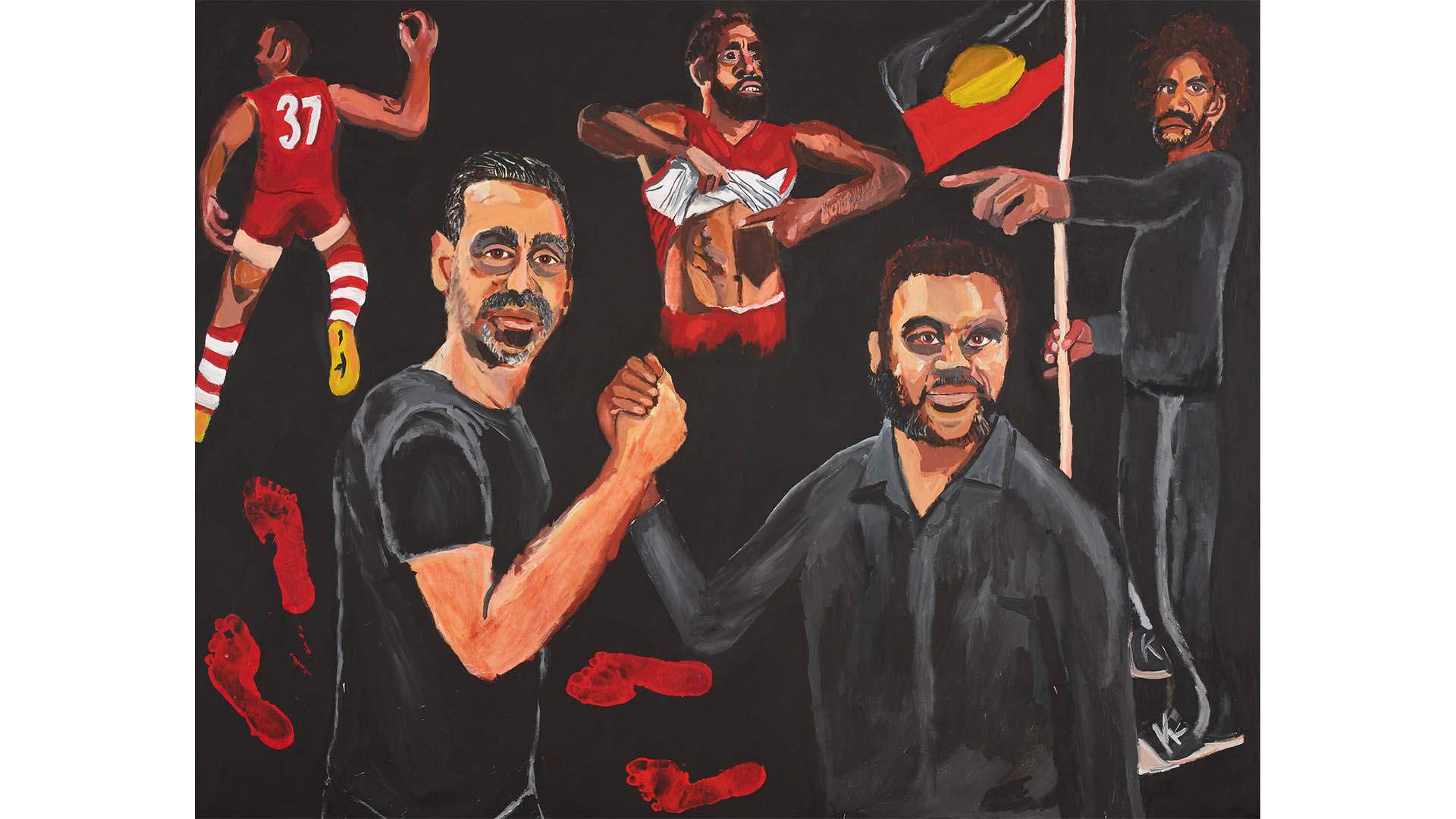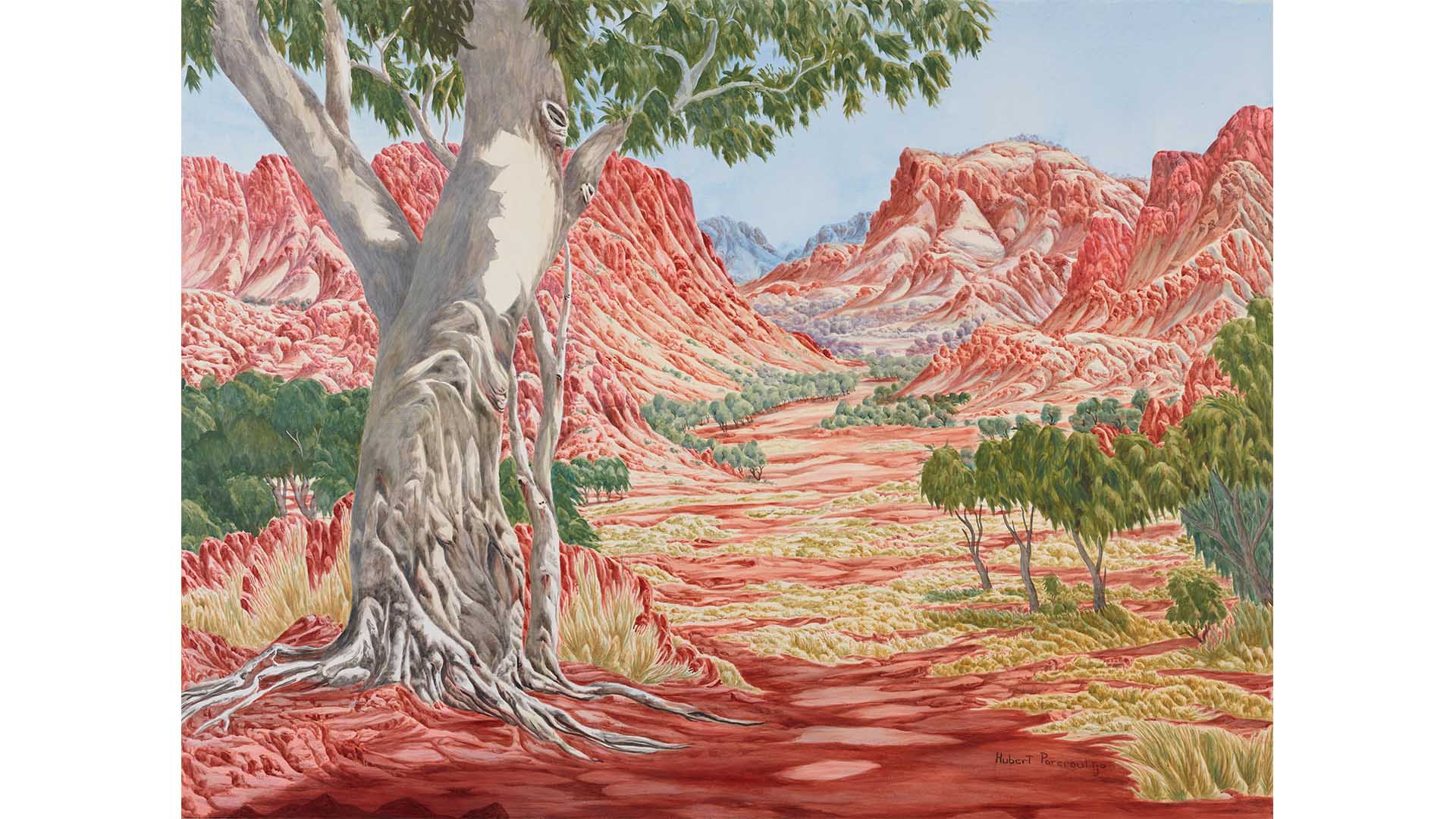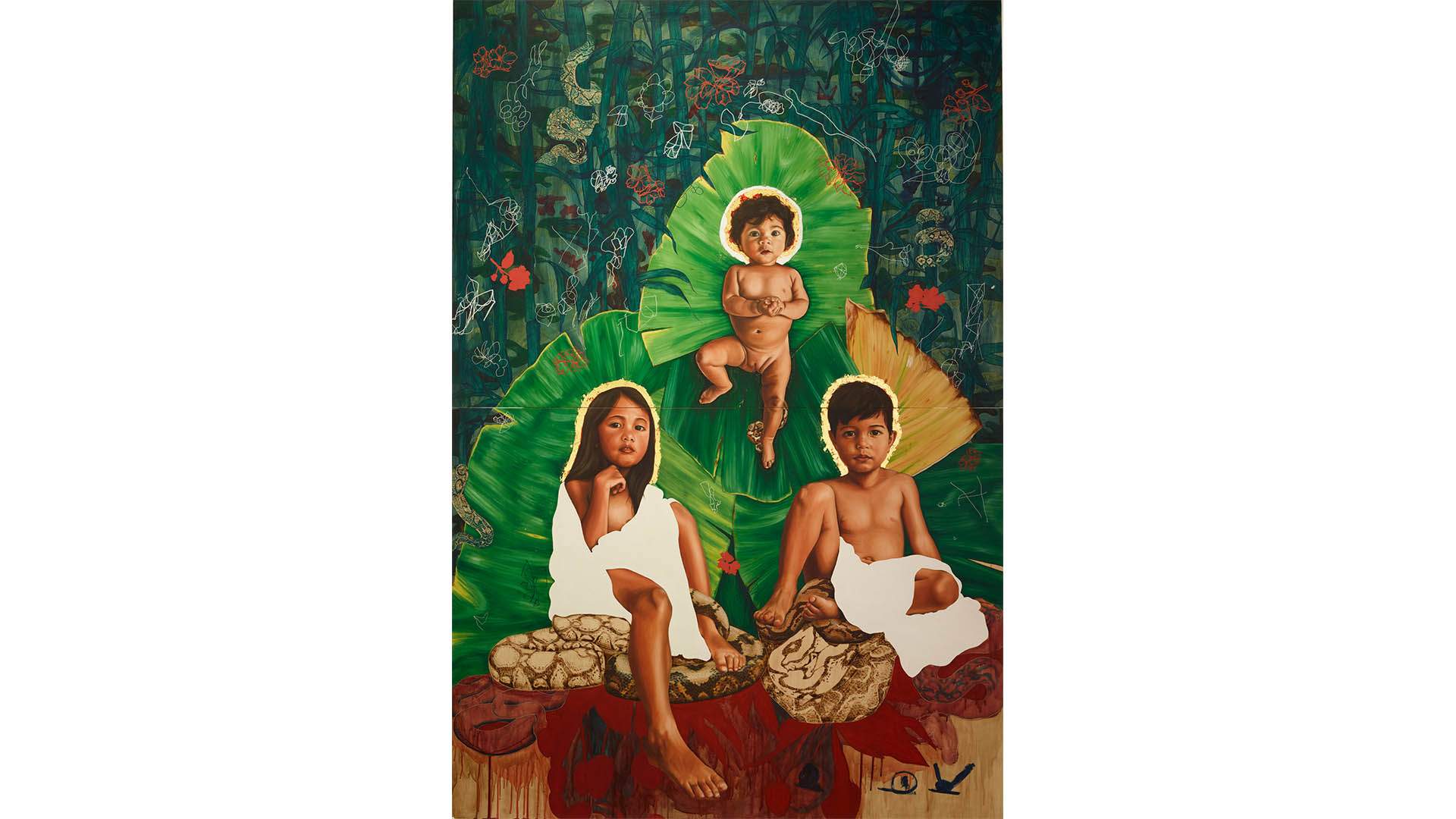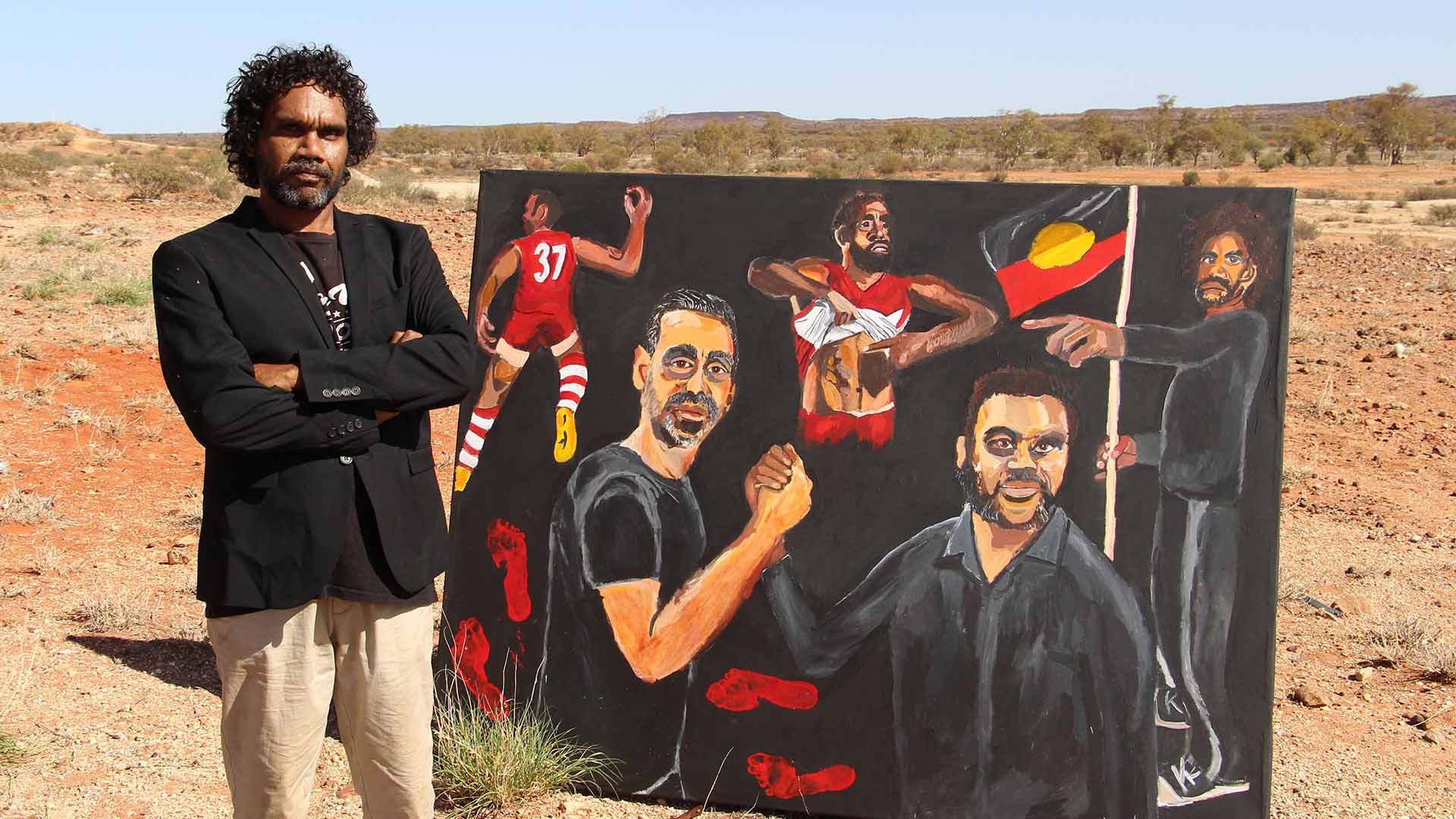Vincent Namatjira's Portrait of Adam Goodes Has Just Taken Out the 2020 Archibald Prize
Namatjira is the first Indigenous artist to win the award in its 99-year history.
When the 2019 Archibald Prize was announced last year, it made history, with a portrait of an Asian Australian taking out the award for the first time in the event's then 98-year run. Now in 2020, the delayed gong has also secured a first — with Vincent Namatjira winning for a portrait of champion AFL footballer Adam Goodes, and his prize marking the first time that the award has gone to an Indigenous artist.
Namatjira's piece, entitled Stand strong for who you are, was chosen from 55 finalists, which were whittled down from a record 1068 entries. Among the other contenders was Wongutha-Yamatji artist Meyne Wyatt's Packing Room Prize-winning self-portrait, which actually became the first work by an Indigenous person to win any of the Archibald's prizes.
In Stand strong for who you are, Namatjira depicts multiple versions of Goodes, including two in his Sydney Swans colours. The artist himself also appears, clasping hands with Goodes. During the latter's AFL career, he played 372 matches for the Swans, kicked 464 goals, won two premierships, earned the code's highest individual honour (the Brownlow Medal) twice and was even anointed Australian of the Year. As his highly decorated time on the field came to an end, however, he was also the subject of merciless booing and verbal attacks by both spectators and high-profile media figures alike — and placed under immense scrutiny for celebrating his Indigenous heritage both on and off the field. That's a topic explored in not one but two documentaries that were released last year: The Final Quarter, which received a standing ovation at last year's Sydney Film Festival, and The Australian Dream, which opened the 2019 Melbourne International Film Festival.
The Mparntwe-born Namatjira actually took inspiration from The Final Quarter. "When I saw the documentary about Adam's final season of AFL, my guts were churning as I re-lived Adam's experiences of relentless racism on and off the field," he explained. "Memories of my own experiences were stirred up and I wanted to reach out and reconnect with Adam." He continued: "When I was younger and growing up in the foster system in Perth, Indigenous footballers were like heroes to me. Goodesy is much more than a great footballer though, he took a strong stand against racism and said, 'enough is enough'. I stand strong with you too, brother".
Accepting the award in a virtual ceremony, Namatjira also advised that "this is a really special moment for me" — while noting that "it only took 99 years" for the Archibald to award its first Indigenous winner. "I feel like this is a very important moment in Australian art. It's an honour to be the first, but I also want to acknowledge all of the Indigenous finalists and Indigenous sitters for the Archibald this year and in past years," he said.
In a statement, Goodes similarly said that he was "thrilled that an Indigenous artist has won the Archibald prize for the first time", and that he was "so pleased that it shines a light on all Indigenous art". He continued: "we have a 60,000 year history of art and culture in our people, and we share this knowledge and gift of culture with all Australia".

Archibald Prize 2020 winner. Vincent Namatjira. Stand strong for who you are. Acrylic on linen, 152 x 198 cm. © the artist. Photo: AGNSW, Mim Stirling. Sitter: Adam Goodes - former professional Australian rules footballer.
In the main field, Tsering Hannaford also received a prize in her sixth time as a finalist, with her self-portrait Allegory of Painting highly commended. The colourful work was inspired by Artemisia Gentileschi's 17th-century portrait, where the artist used two mirrors to observe herself in the act of painting.
The winners of the Wynne and Sir John Sulman prizes were also revealed today, spanning a number of other pieces. Western Aranda artist Hubert Pareroultja took out the former — which awards the best landscape painting of Australian scenery or figure sculpture — for Tjoritja (West MacDonnell Ranges, NT). The striking work "represents the story of the giant caterpillars called the Yeperenye that became mountain range".

Wynne Prize 2020 winner. Hubert Pareroultja. Tjoritja (West MacDonnell Ranges, NT). Acrylic on canvas, 183 x 244 cm. © the artist. Photo: AGNSW, Mim Stirling
This is the fifth year in a row that an Indigenous Australian artist has been awarded the Wynne prize, with the category also handing out three other gongs. Nyunmiti Burton was highly commended and received the Roberts Family Prize for Seven Sisters, while Julianne Ross Allcorn won the Trustees' Watercolour Prize for triptych Mollitium 2, which celebrates the resilience of the Australian bush.
The Sir John Sulman Prize goes to the best mural, subject or genre painting, and was this year awarded to Marikit Santiago's work entitled The divine. Describing the piece, the artist explained that it "considers what is inherited by our children".

Sulman Prize 2020 winner. Marikit Santiago. The divine. Acrylic, oil, pen, pyrography and 18ct gold leaf on ply, 179.5 x 120.5 cm. © the artist. Photo: AGNSW, Jenni Carter
The winning portraits and finalists will be on display at Sydney's Art Gallery of NSW from tomorrow — Saturday, September 26 — up until Sunday, January 10. If you do't agree with the judges, you can cast your own vote for People's Choice before Sunday, December 13.
ARCHIBALD PRIZE 2020 DATES
Art Gallery of NSW, Sydney — September 26–January 10
Tweed Regional Gallery & Margaret Olley Art Centre, NSW — January 22–March 7
Cairns Art Gallery, Qld — March 19–May 2
Griffith Regional Art Galley, NSW — May 14–June 27
Broken Hill Regional Art Galley, NSW — July 9–August 22
Shoalhaven Regional Gallery, NSW — September 3–October 17
Penrith Regional Gallery, NSW — October 29–December 5
If you can't make it to any of the above dates, you can check out the award winners and finalists of the Archibald, Wynne and Sulman Prizes on the Art Gallery of NSW website.
Top image: courtesy of the artist and Iwantja Arts.





